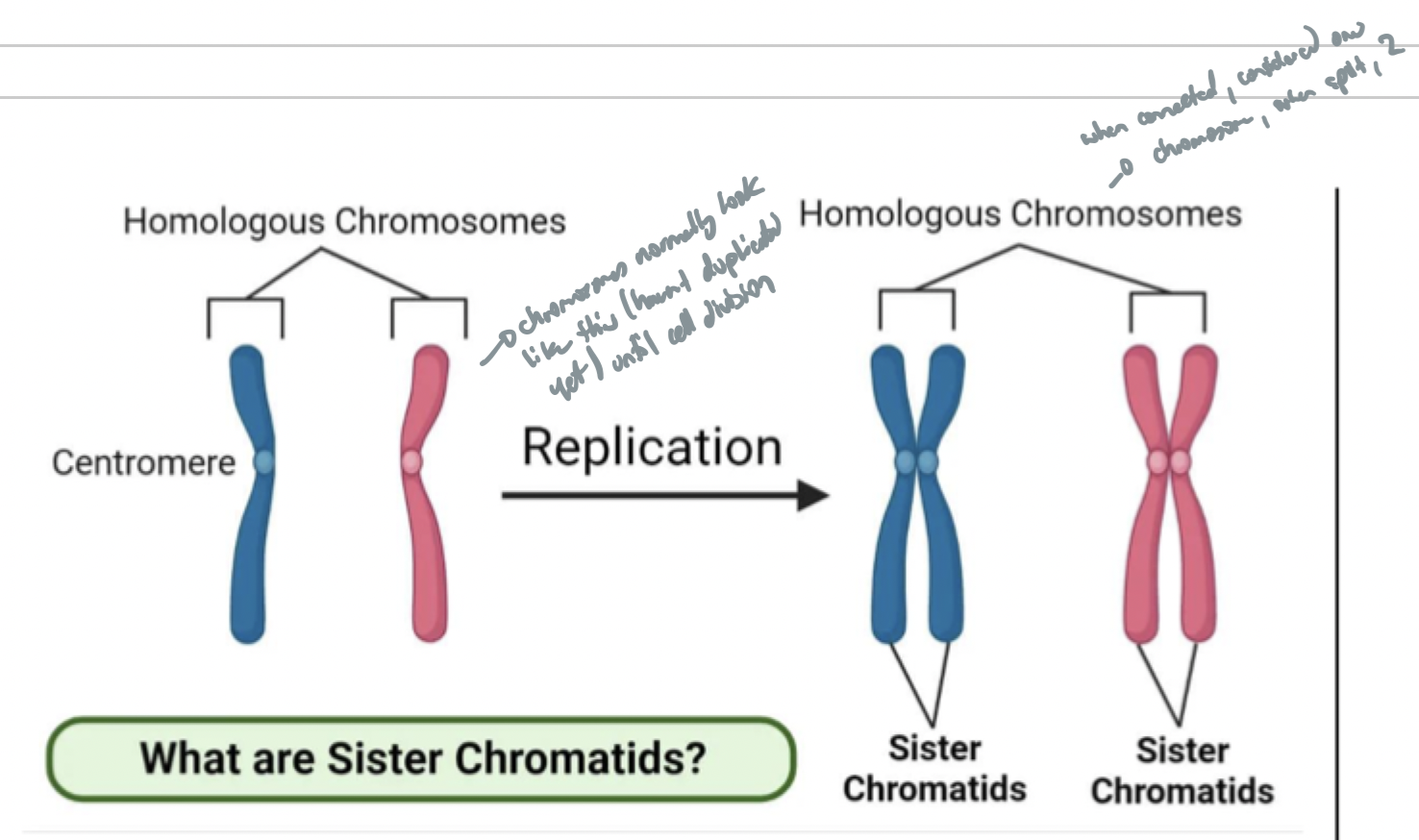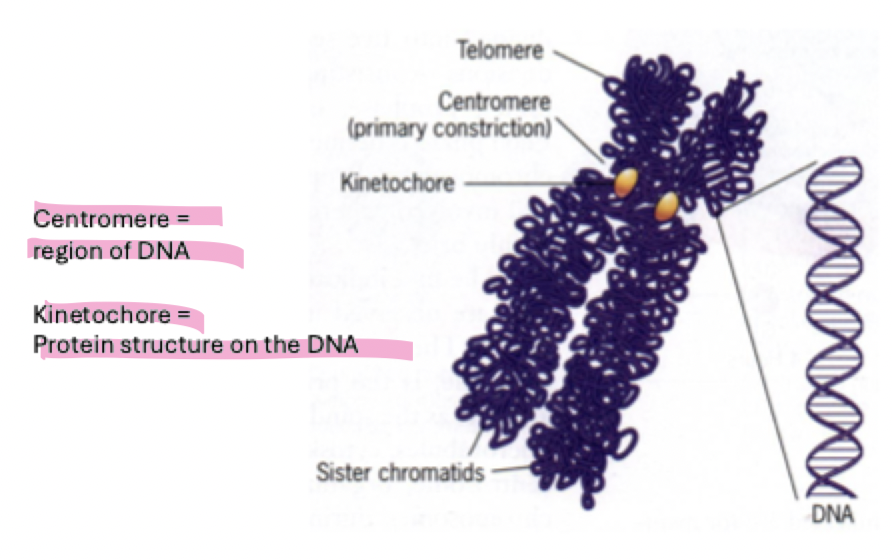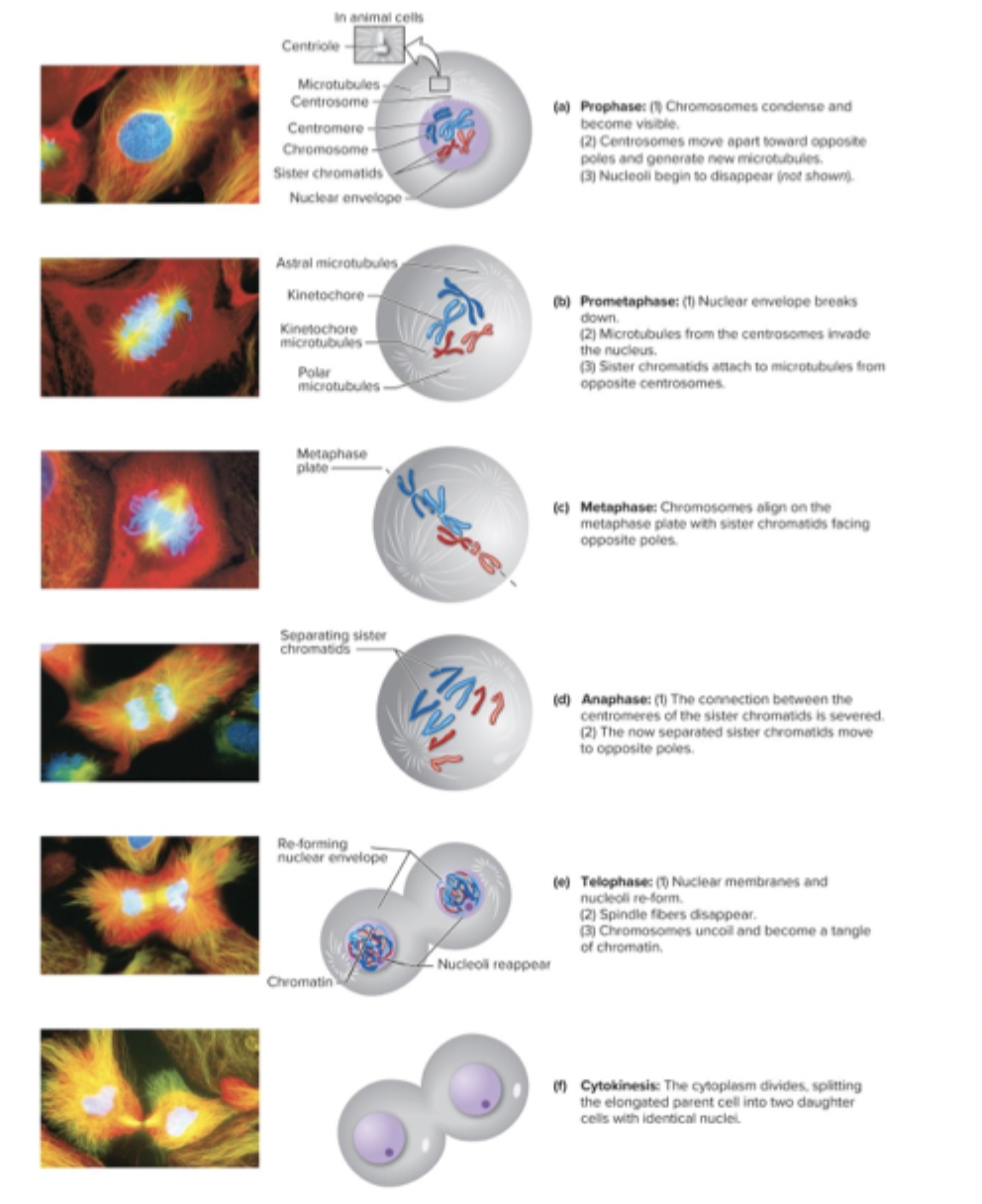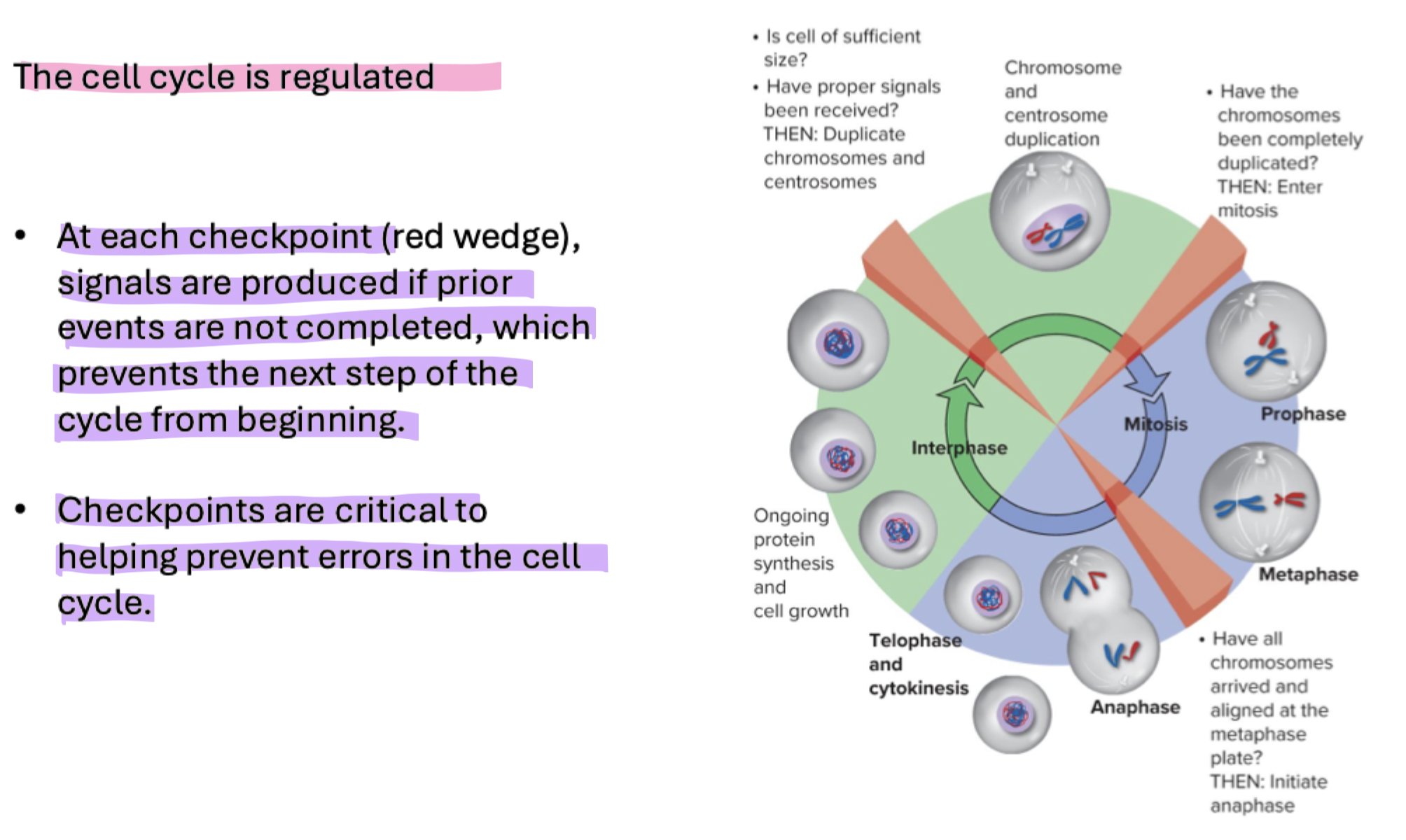Lecture 6: Chromosomes and Mitosis
1/58
There's no tags or description
Looks like no tags are added yet.
Name | Mastery | Learn | Test | Matching | Spaced |
|---|
No study sessions yet.
59 Terms
what is hereditary info found on
genes
where are genes located
on chromosomes
t/f: eggs and sperm contribute equally to the genetics of offspring through their nuclei
true
what are karyotypes
pictures of every chromosome in a cell
what can be seen about chromosomes in karyotypes
how many chromosomes the organism has (including mono/di poloidy, etc), size, number, shape, and banding pattern
how would you expect chromosomes of a diploid organism to appear in a karyotype
in pairs
in what cell phase and in which cells are pictures to be used to make karyotypes taken in
metaphase chromosomes and in somatic cells (NOT GERM CELLS) → won’t have all the chromosomes (half)
what are autosomes
all chromosomes except x and y (sex chromosomes)
what are sex chromosomes
x and y chromosomes (1 pair in humans)
humans with which chromosomes are assigned male vs female at birth
male - xy
female - xx
t/f: having (only) 2 x chromosomes always means you are born female (across species)
no → sex determination isnt the same in all species
are males or females heterogametic vs homogametic, etc
males - heterogametic
females - homogametic ( 2 of same sex chromosome)
t/f: females are always the homogametic sex
false
explain the difference in human vs drosophila (fruit flies) in sex determination
both: typical male = xy, typical female = xx
humans: as long as there is >1 Y, the individual is male
Y chrom determines sex
drosophila: at least 2 X chroms, the individual is female
X chrom determines sex

t/f: individuals can have more or less than two sex chromosomes
true
what is a good rule of thumb to determine, in humans, if individuals will be male if they have more than one chromosome
as long as there is at least one y, the individual is male

t/f: humans need at least 1 sex chromosome to be viable
true
what are the 2 major processes of cell division
mitosis and meiosise
what is mitosis
nuclear division that results in 2 daughter cells → each containing identical numbers of chromosomes to parent cell
produces clones of parent cell
what is meiosis
nuclear division that results in 2 daughter cells, each containing half of the number of chromosomes found in other (somatic) cells
produces cells that are unique compared to parent cell
what are diploid cells
have 2 complete sets of chromosomes
most body cells are diploid
mitosis produces diploid cells from a diploid parent cell
what does meiosis do
produces haploid (n) gametes (sperm or eggs)
haploid cells (daughter cells in this case) have one copy of each chromosome
what does n stand for in genetics
n = number of chromosomes in a normal gamete
what is the diploid and haploid number in humans
diploid: 2n = 46
haploid: n = 23
what is the diploid and haploid number in drosophila
diploid: 2n = 8
n = 4
what is a chromatid
one copy of a newly copied chromosome that is still joined to the other copy by a single centromere


what are nonhomologous chromsomes
contain different genes
do not pair at meiosis
what are homologous chromosomes
members of a chromosome pair
contain the same genes (can be different alleles, though)
pair at meiosis
sister chromatids
identical copy of an individual chromosomes
identical alleles for all genes
how long would the DNA molecule that makes up each human chromosome be

what is the cell cycle
an alternation between interphase (normal cellular activity) and mitosis (cell division)
what is the G0 stage
when some terminally differentiated cells (eg mature neurons) stop dividing and enter G0 stage
how long does the cell cycle take
rapidly proliferating human cells go through the cell cycle in ~24 hours
in yeast, the cell cycle is ~90 minutes
in an early embryo, its ~30 minutes
explain the G1 phase
Part of interphase (interphase gap/growth phase 1)
cells are actively producing products specific to their biological role in the body
varies in length, depending on cell type
some cells (eg. human nerve cells) do not divide and stay in G1 (in which case it gets termed G0)
The cell is metabolically active, growing, and preparing for DNA replication.
In G₁, the cell:
Increases in size
Synthesizes proteins and organelles
Checks for DNA damage before entering S phase (where DNA is duplicated)
explain S phase:
part of interphase - DNA synthesis
duplication (synthesis) of chromosomes to produce identical sister chromatids
sister chromatids remain joined at the cemtromere
DNA must be “open” for replication, not condensed (unwinds to create chromatin, wouldnt look like the standard pic of a condensed chromosome)
in animal cells, centrosomes (structures involved in cell division) also need to replicate to produce two centrosomes
explain the G2 phase
part of interphase - Gap 2 Phase / Growth Phase 2
phase just before mitosis
cell synthesis proteins necessary for mitosis and cell division are produced
what are some key aspects of mitosis
it is cell division resulting in 2 daughter cells
daughter cells are genetically identical to each other and parent cell
daughter cells have same number and kind of chromosomes as the parent nucleus
Mitosis is typical of ordinary tissue growth or of asexual reproduction in single-celled eukaryotes
Explain the diff between Mitosis and Binary fission
Mitosis is a eukaryotic process
→ eukaryotic nuclei typically have multiple linear chromosomes
Prokaryote cell division / reproduction occurs via binary fission
→ procaryotes do not have nuclei and usually have a singular circular chromosome
what are the 5 phases of mitosis? briefly explain each
Prophase
chroms condense and become visible
Prometaphase
nuclear envelope (membrane surrounding nucleus) breaks down, spindle forms, and sister chromatids attach to microtubules from opposite centrosomes
Metaphase
chroms align at cell equator
Anaphase
sister chromatids separate and move to opposite poles
Telophase
spindle disapears, chroms decondense, and are enclosed in 2 nuclei
explain prophase
chroms condense and become visible
2 centrosomes (formed during S phase) move apart → each migrating to their own opposing pole of the cell
microtubules (proteins) begin to extend from centrosomes
nucleoli (regions of nucleus where ribosomes live) begin to disappear
what are centrosomes and what do they consist of
centrosomes are structures that consist of 2 centrioles plus other proteins (microtubules they expel)
explain the diff btwn centrosomes and centromeres
centrosomes consist of a pair of centrioles (structures that secrete microtubule proteins)
a centromere is the middle region of chromosomes where sister chromatids join

what are kinetochores
protein structures at. the centromere on chromosomes → the thing on centromeres that connect to the microtubules in prometaphase
explain prometaphase
nuclear mem breaks down
microtubules from centrosomes attach to kinetochores in the centromere of each sister chromatid
sister chromatids attach to microtubules from opposite poles
where do the 3 types of microtubules (kinetochore, polar, and astral) microtubules originate from respectively and what do they all work tg to form
all originate from the centrosome and form the mitotic spindle
what does mitotic spindle consist of
the 3 types of microtubules (kinetochore, polar, and astral)
what do kinetochore microtubules do
attach to kinetochores
what do polar microtubules do
are directed towards the middle of the cell from each pole, pushing them further away from each other in prometaphase
what do astral microtubules do
extend towards the cell’s periphery, help ensure spindles are oriented so they will pull chromosomes towards poles of cell
explain metaphase
chroms align on metaphase plate (middle of cell)
sister chromatids face opposite poles of the cell
forces pushing/pulling chroms to or from each pole are balanced, which keeps chroms in place
explain anaphase
sister chromatids of all chroms simultaneously separate at their centromere
separated sister chromatids move to opposite poles via shortening kinetochore microtubules → disjunction
chromatids have characteristic “v shape” at this stage
explain telophase
nuclear mem (envelope) forms around each group of chromatids
nucleoli re-form
spindle fiber disappears
chroms uncoil and reform as chromatin
explain cytokenisis
cytoplasm of parent cell splits into 2 daughter cells w identical nuclei
beings during anaphase but isnt complete until after telophase
t/f: cytokenisis is diff in plant and animal cells
true → bc plant cell walls are too thick so cant “pinch off” (so they have a diff process)
summary of mitosis

t/f: the cell cycle is unregulated
false
